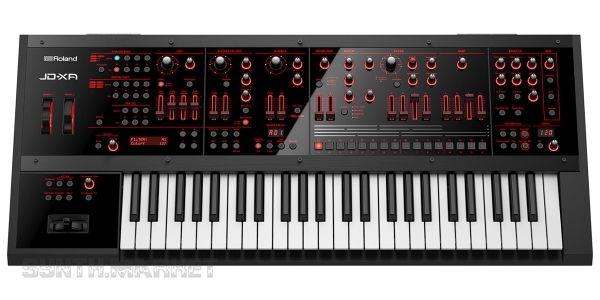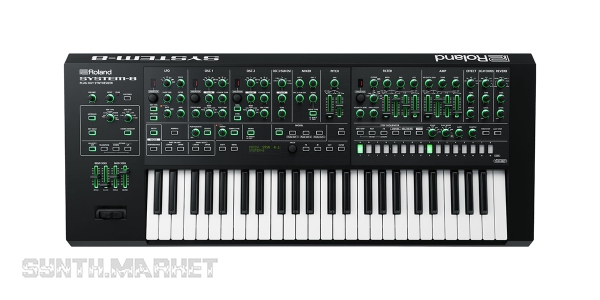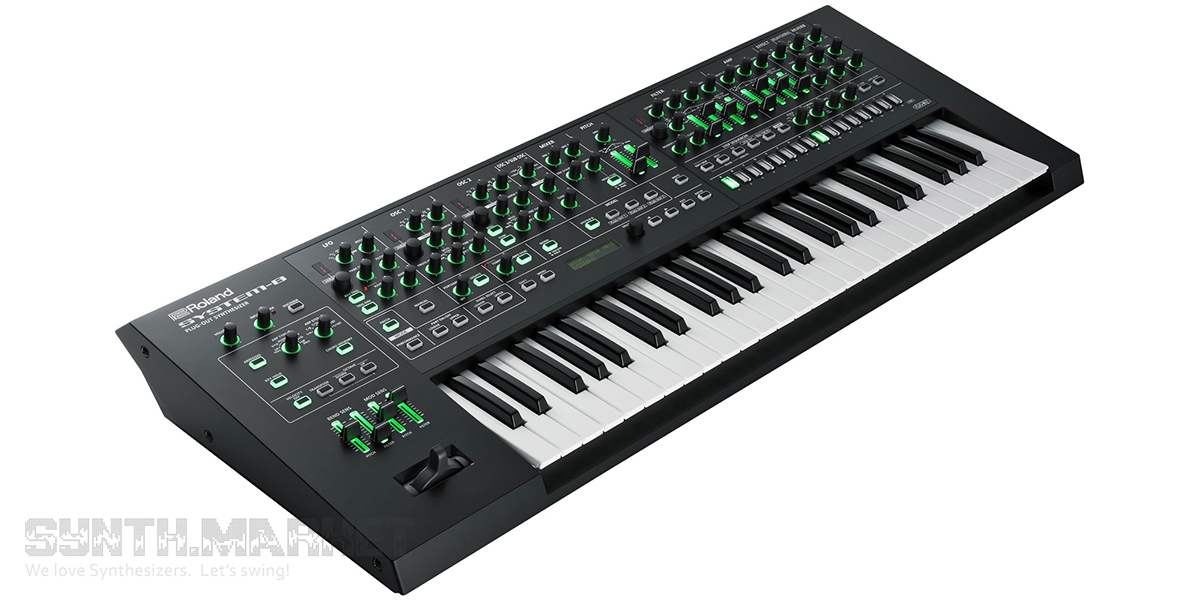Therefore not just being red and green makes them so different. And it’s not only about technical disaccord with each other because Roland System-8 seems to be absolutely unique in comparison to any analog modeling synth of its class and this is mainly due to ACB and Plug-out technologies already time-tested in System-1/ System-1m but System-8 goes further perfecting all the functions. Plug-out technology gives an opportunity to get several sound models of the famous Roland synthesizers at once in one device turning System-8 into exact copy of one of the predecessors that will not only sound identically (and there is every reason to believe that even better, so to say perfect which at the same time means no original voltage drawbacks, though Roland might arrange some in future to please the purists) but will possess the same control set. Jupiter-8 and Juno-106 are already in! Soon SH-101, SH-2 and Promars will be available, others (likely Jupiter-4/6 and JX-3P) – a bit later.
3 Plug-out slots and Performance mode let you switch sound engines in no time combining its own generator with the loaded models (System-1 couldn’t function like that) and making of it quite a peculiar hybrid unseen before. Now what does System-8 offer itself? Basically it gives an elaborate version of Analog Circuit Behaviour (ACB) technology (well-known thanks to AIRA previous releases) which recreates the components of analog synthesizers thus achieving their sound, behaviour and temper during a performance.
All in all System-8 is a 49-note keyboard with 8 voices; 3 oscillators (each of two has 6 waveforms in 2 variations and the third one generates sine and triangle, may serve as a sub-oscillator as well) with LFO, pitch, filter and amp envelope each as a modulation source; white and pink noise; smooth and sensitive filters that easily take over the filter features of the plug-out models. Its 64-step sequencer reminds of Roland TR-REC and captures every regulator or fader motion during a playback also supported by a useful Chord Memory function and arpeggiator switching patterns while performing. The effects selection lives up to expectations as well as doubled System-1’s resolution of controllers.
Roland JD-XA is a no compromise hybrid of a 4-voice analog synth (fully analog signal path and 4-part multitimbral) and a digital engine (64 voices, 4x3-part multitimbral) based on SuperNATURAL technology. JD-XA impresses with its powerful effects set too. Analog and digital parts can be used individually or interacted making it possible to combine signals of different origin or, for example, put digital sound through analog filters.
Both sections seem to be two independent synthesizers: discrete analog 4-part engine comprises 2 oscillators (cross modulation, ring modulation and sync), filter (4-pole, ladder and multimode), amplifier, 4 envelope generators, 2 LFO (from ultra slow to ultra fast range rate) per voice and Analog Dry Out; digital section is presented by 4-part SuperNATURAL engine with 64 voices and INTEGRA-7, MFX libraries compatible.
There is nothing wrong with it having neutral factory presets, it’s completely compensated with the architectural complexity since JD-XA functionality inspires a musician to use his imagination and create his own patches. The sequencer won’t let you switch and save patterns in real time, neither it will offer any whimsy timing, but 16 tracks are manageable by external MIDI devices or analog synthesizers which is enough to not get bored. Thanks to its offbeat concept JD-XA stands out as one of the Roland’s greatest products since V-Synth despite its seeming cheapness except, of course, the technical structure which generates unique sound of Rolnad’s werewolf synth.
Considering commutation JD-XA is great for analog systems invasion – he’s got Analog Dry Out, a couple of CV outs and Gate outs. Whereas System-8 possesses only one couple of CV/Gate outs but has a Trigger IN. JD-XA offers a built-in vocoder and microphone XLR IN while System-8 doesn’t but it has a stereo line level input for external sources. Both of them have Hold and Control pedal jacks, MIDI in/out, USB out, when JD-XA also possesses USB IN for thumb drives.
Both have 4-octave keyboards though JD-XA owns monophonic aftertouch but there was no point for System-8 to worry about that since all the models it recreates don’t have it as well. On the whole JD-XA’s panel offers a bit more controllers and assignable wheels when System-8’s nice option is 4 sliders for quick pitch and mod setup.
These are absolutely different instruments, both of them will or already have their supporters – some of them would fully stand up for System-8 and some would exalt JD-XA. Still there will be some who accept everything good coming their way and worthy to pick up in a collection, any studio would need System-8 together with JD-XA, why prefer one hit product to another?
Again, some will say that System-8 is an ACB emulator of Roland’s iconic synthesizers while JD-XA sports real analog and digital voices (DCO+VCF+VCA) or may set their minds on a thought-out sequencer of System-8 performing functions of which were more or less limited in JD-XA. JD-XA is responsible for sonic layers sculpturing but System-8 is a transformer comprising several Roland’s synths with company’s top-notch quality that excelled all the other AIRA instruments. You won’t take a dig at the Analog Circuit Behaviour proprietary class because no one was left disappointed. The technology has been perfected in such a detail it puts a question whether Roland broke into the market too soon with their “transformer synth”, because JD-XA seems quite alive to fight its recent №1 position back.
Anyway both of them are not interchangeable. JD-XA impresses with its structure while System-8 draws over due to its structure stealing nature. JD-XA is a digital synthesizer in the first place (though reasonably considered to be analog). But System-8 pretends to be other analog synthesizers so damn good one may forget it’s digital.
After System-8 appeared on the shelves together with some rival brands competitors JD-XA went down in value a bit having lost 10% in a year and even new one might be available now for $1800. System-8 has nailed its price at $1500 and is ready to ship. Should we benefit from Roland’s impulsiveness and wait for another super machine which will step on System-8 and trample it down to $1200-1300 or take it as it is for $1500? Because it’s quite a fair price for an all-in-one bargain if we think about its plug-out advantage.
And finally, $3000 for both of them? Ridiculously decent! Doesn’t seem so? Well either the piece needs a second read or Roland simply failed to surprise.




